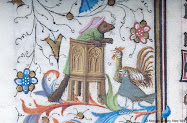When I'm travelling, I often get the most joy from those quirky little spots that are well off the mainstream tourist routes. Today, guided by a locally produced photocopied pamphlet (in French and complete with spelling mistakes and some very fuzzy photos), I set off on foot to explore the hidden charms of the village of Brandivy and environs. Like so many small villages in this region, it boasts more than its fair share of shrines, churches, and medieval ruins. Thanks to my trusty pamphlet, I was also apprised of some of the local legends relating to these spots. My favourite story concerns 'La Tombe des 7 trous' (tomb of seven holes), a shrine marked by an old stone cross on the side of the track in the local forest. According to the folktale, a holy hermit was travelling along this path when he was set upon by two bandits. He had just enough time to brandish the Host at them before they cut off his head, but the head refused to die. Instead, it bounced around seven times, making seven holes in the ground where nothing has grown since! This story has a bittersweet epilogue, as today the shrine is still occasionally visited by parents seeking a cure for children who have problems walking, and it is garnished with little baby shoes and booties.
At the much less fantastic end of the scale, another large stone in the neighbourhood - the 'Stele des Martyrs' - commemorates seven 'young patriots' who were killed by the Germans in 1944. This area was a hotbed of Maquis Resistance and when you see the countryside, its every lane lined with thick drystone walls and deep bramble-filled ditches, you can see why it offered great opportunities for guerrilla warfare against the German occuption. In this case, the bodies of three of the seven dead - sons of one of the nearby villages - were taken to the local chapel, but the night before their funerals the bodies were stolen by the Germans and never seen again.
There is even a little touch of the Da Vinci Code in the 'hood with the stories about La Motte Feodale de Lanvaux, the ruins of a medieval keep dating from the 11th and 12th centuries. Today, there is nothing left but some reasonably substantial outer walls built of stone, but local legend has it that this was one of the places where the Order of the Knights Templar stashed their treasure after they were attacked by Philippe le Bel. Some decades ago, the treasure-hunting became so intense here that much of the structure was seriously undermined by people digging holes in it. Because of this, sadly, you are no longer allowed to clamber amongst the ruins. But when I walked around them, all alone on a quiet rain-fogged afternoon, the overgrown, crumbling stone still created a powerful sense of gothic romance. (Seriously, I felt like Catherine Morland reading 'The Mysteries of Udolpho'!)
Monday, June 25, 2012
Subscribe to:
Post Comments (Atom)




No comments:
Post a Comment